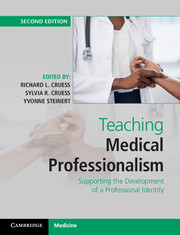Book contents
- Frontmatter
- Contents
- List of contributors
- Foreword
- Introduction
- Part I What is to be taught and learned
- 1 Professionalism and professional identity formation: the cognitive base
- 2 Developing a professional identity: a learner's perspective
- Part II Theory
- Part III Principles
- Part IV Case studies in promoting professionalism and professional identity formation across the continuum
- Part V The future
- Index
- References
2 - Developing a professional identity: a learner's perspective
from Part I - What is to be taught and learned
Published online by Cambridge University Press: 05 April 2016
- Frontmatter
- Contents
- List of contributors
- Foreword
- Introduction
- Part I What is to be taught and learned
- 1 Professionalism and professional identity formation: the cognitive base
- 2 Developing a professional identity: a learner's perspective
- Part II Theory
- Part III Principles
- Part IV Case studies in promoting professionalism and professional identity formation across the continuum
- Part V The future
- Index
- References
Summary
It was August 2005, and I had just found an empty seat in the auditorium where my first lecture as a McGill medical student would be held. The Dean of the Faculty of Medicine was about to address the class, and his opening words were ones that I still think about to this day: “Today, you begin your transformation from being a lay-person to being a physician.” I was very unsettled by this statement, and my mind began to race. What does it mean to be a physician? To be a physician, do I have to stop being who I am? Is being a doctor going to be what I do, or who I am? As unsettling as these questions were, I was intrigued by the notion that I was going to change, and even began to look forward to seeing how this process would unfold. Throughout my training, I learned valuable lessons about the professional values that I needed to adopt, the behaviors that I needed to demonstrate, and the responsibilities that I needed to uphold in order to become a physician. This provided me with an important framework in which to understand medical professionalism; however, my personal transformation from a medical student into a pediatrician, and all of the intermediate steps in between, were rarely formally explored.
Having completed my undergraduate and postgraduate medical training at McGill University in 2009 and 2014 respectively, my professionalism education was based on the work of Cruess and Cruess that influenced much of the teaching of medical professionalism over the last fifteen years.1,2 At the core of this work were two key principles: (1) medical professionalism needs to be taught explicitly; and (2) the objective of this teaching is to ensure that students understand, demonstrate a commitment to, and internalize the values of the profession. As such, the focus was primarily on the “doing” of professionalism. As has been discussed in Chapter 1, professionalism education hopes to reframe its focus from the “doing” of professionalism to the “being” of a professional. In other words, ensuring that students understand and demonstrate professionalism is no longer the objective but, rather, an important step in the ultimate goal of supporting learners in the formation of their professional identity.
- Type
- Chapter
- Information
- Teaching Medical ProfessionalismSupporting the Development of a Professional Identity, pp. 26 - 36Publisher: Cambridge University PressPrint publication year: 2016
References
- 6
- Cited by

